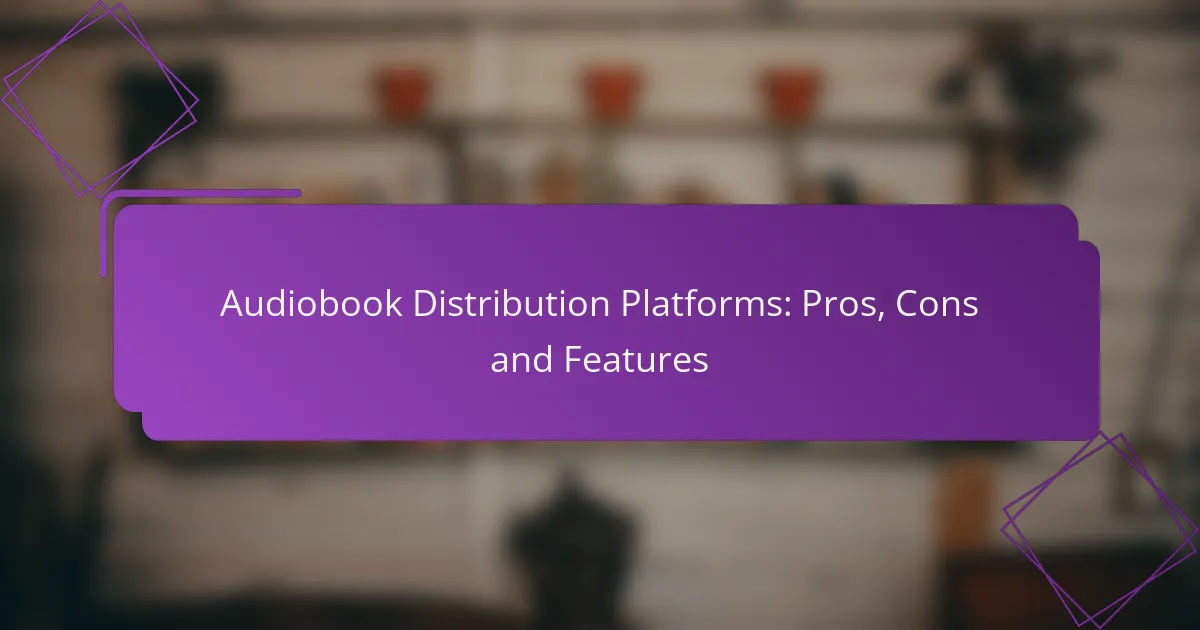Audiobook distribution platforms play a crucial role in helping authors reach wider audiences by offering various features and benefits tailored to different needs. While these platforms enhance visibility and simplify the monetization process, they also come with challenges such as high commission fees and limited pricing control. Understanding the pros and cons of each platform is essential for authors looking to maximize their audiobook’s potential.
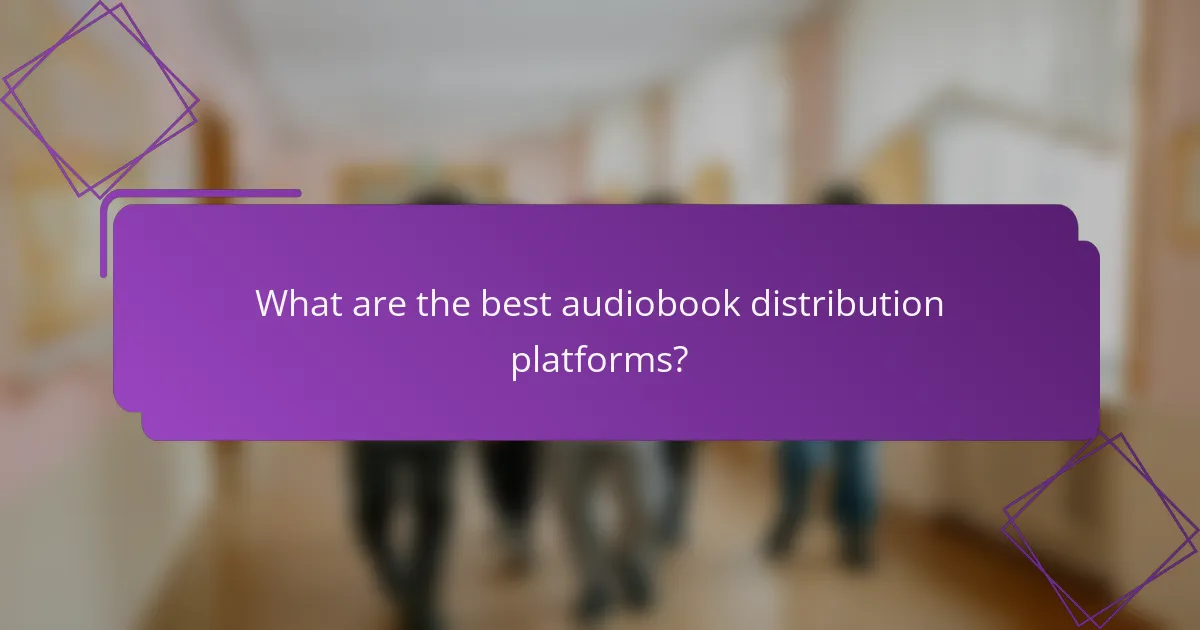
What are the best audiobook distribution platforms?
The best audiobook distribution platforms provide authors with various options for reaching audiences, each with unique features and benefits. Key platforms include Audible, Findaway Voices, Kobo Writing Life, Google Play Books, and Apple Books, each catering to different needs and preferences.
Audible
Audible is one of the most recognized audiobook platforms, offering a vast library and a subscription model that attracts millions of listeners. Authors can distribute their audiobooks through Audible via ACX, which connects them with narrators and production resources.
Consider the competitive royalties, which can range from 25% to 40% depending on the distribution choice. However, exclusivity with Audible may limit your reach to other platforms.
Findaway Voices
Findaway Voices is a versatile platform that allows authors to distribute audiobooks to numerous retailers and libraries worldwide. It offers a user-friendly interface and various production options, including access to professional narrators.
Royalties are generally favorable, around 60% of the retail price, and authors retain rights to their work. This platform is ideal for those looking for broad distribution without exclusivity constraints.
Kobo Writing Life
Kobo Writing Life provides authors with a straightforward way to publish and distribute audiobooks alongside eBooks. It is particularly popular in Canada and Europe, making it a good choice for reaching international audiences.
Royalties are competitive, typically around 70% for sales above a certain price point. Authors should note that Kobo’s audiobook catalog is smaller compared to Audible, which may affect visibility.
Google Play Books
Google Play Books allows authors to distribute audiobooks directly to Android users and those using Google services. This platform offers a pay-as-you-go model, which can be appealing for those who prefer not to commit to a subscription service.
Royalties can vary, but authors often see around 70% of sales. Keep in mind that Google Play Books requires a Google account and adherence to specific guidelines for publishing.
Apple Books
Apple Books is a key player in the audiobook market, especially for users within the Apple ecosystem. Authors can publish their audiobooks directly through Apple, reaching a large audience of iPhone and iPad users.
Royalties are typically around 70%, and the platform supports various formats. However, authors must navigate Apple’s submission process, which can be more stringent than other platforms.
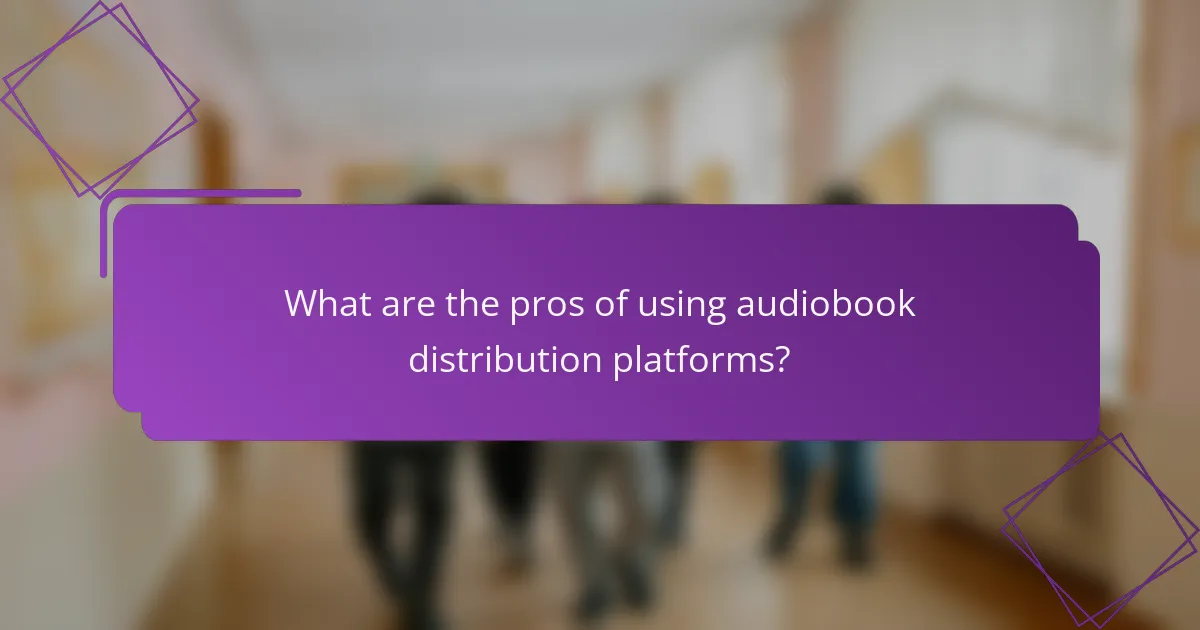
What are the pros of using audiobook distribution platforms?
Audiobook distribution platforms offer numerous advantages, including enhanced visibility for authors and access to a broader audience. These platforms streamline the process of getting audiobooks into various markets, making it easier for creators to monetize their work.
Wide audience reach
Audiobook distribution platforms significantly expand an author’s audience reach by connecting them with listeners across multiple regions. With platforms like Audible, Google Play, and Apple Books, audiobooks can be accessed by millions of potential customers worldwide.
Additionally, many platforms cater to specific demographics or genres, allowing authors to target niche markets effectively. This targeted approach can lead to higher engagement and sales, as the content reaches listeners who are genuinely interested in the material.
Multiple sales channels
Using audiobook distribution platforms allows authors to sell their work through various channels, increasing sales opportunities. Instead of relying on a single outlet, authors can distribute their audiobooks to multiple retailers and libraries, maximizing their potential revenue.
For instance, platforms often enable authors to choose between direct sales, subscription models, or library lending options. This flexibility allows creators to tailor their distribution strategy based on their goals and audience preferences.
Marketing support
Many audiobook distribution platforms provide marketing support to help authors promote their titles effectively. This can include promotional tools, featured listings, and access to advertising opportunities that enhance visibility.
Authors can also benefit from analytics and insights offered by these platforms, which help them understand listener behavior and refine their marketing strategies. Leveraging these resources can lead to increased sales and a stronger author brand in the competitive audiobook market.
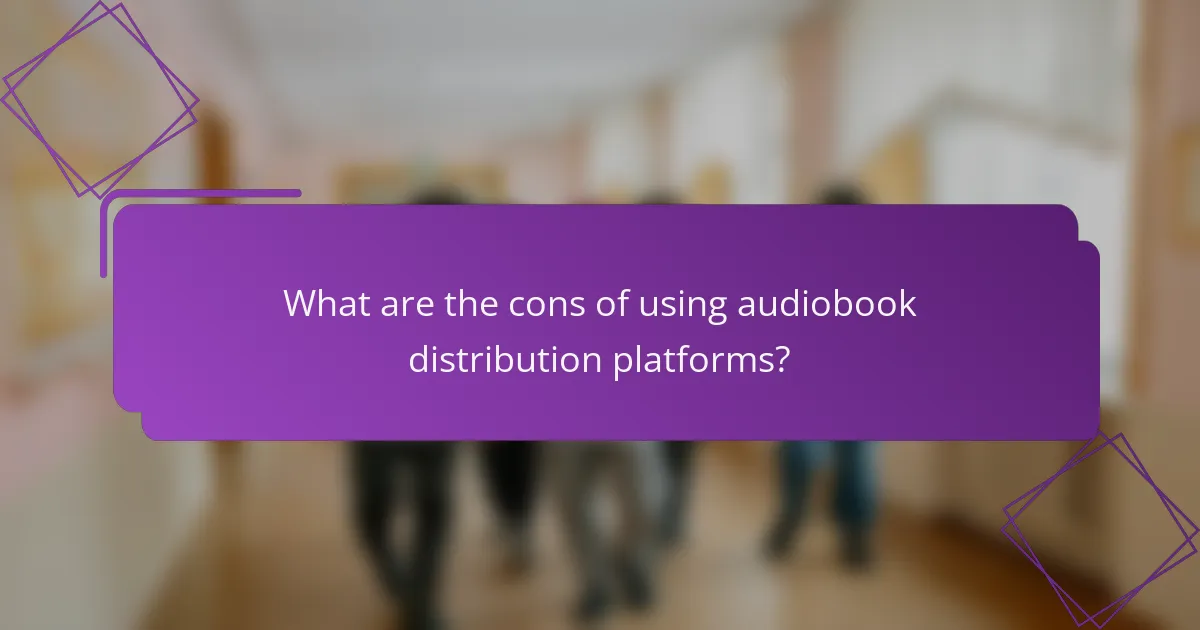
What are the cons of using audiobook distribution platforms?
Audiobook distribution platforms can present several drawbacks for authors and publishers. Key issues include high commission fees, limited control over pricing, and complex distribution agreements that may complicate the publishing process.
High commission fees
Many audiobook distribution platforms charge significant commission fees, often ranging from 20% to 50% of sales. This can substantially reduce the earnings for authors, especially if the audiobook is priced competitively. It’s essential to evaluate the fee structure of each platform to understand how it impacts overall profitability.
For example, if an audiobook sells for $20 and the platform takes a 30% commission, the author only receives $14. This can be a considerable loss, particularly for independent authors relying on direct sales for income.
Limited control over pricing
Using distribution platforms often means authors have limited control over how their audiobooks are priced. Many platforms set minimum and maximum price points, which can restrict pricing strategies. This limitation can hinder promotional efforts or the ability to adjust prices based on market demand.
Authors may find themselves unable to offer discounts or special pricing during events, which can impact sales and visibility. Understanding each platform’s pricing policies is crucial for authors looking to maximize their revenue.
Complex distribution agreements
Distribution agreements with audiobook platforms can be complex and lengthy, often filled with legal jargon that may be difficult to understand. These agreements can include clauses that limit the author’s rights or require exclusivity, which can restrict future publishing opportunities.
Before signing any agreement, authors should carefully review the terms and consider consulting a legal professional. It’s important to ensure that the agreement aligns with their long-term goals and does not impose unnecessary restrictions on their work.

How do audiobook distribution platforms compare?
Audiobook distribution platforms vary significantly in terms of commission rates, royalty structures, and distribution reach. Understanding these differences is crucial for authors and publishers to maximize their earnings and audience exposure.
Commission rates
Commission rates refer to the percentage of sales that platforms retain from audiobook sales. These rates typically range from 15% to 30%, depending on the platform and the distribution model chosen. For instance, platforms like Audible may charge higher commissions compared to others that offer wider distribution.
When selecting a platform, consider how commission rates will impact your overall profits. Lower commission rates can lead to higher earnings per sale, but may come with trade-offs in terms of reach or marketing support.
Royalty structures
Royalty structures determine how much authors earn from audiobook sales after commissions are deducted. Most platforms offer either a flat royalty rate per sale or a tiered structure that increases earnings based on sales volume. For example, some platforms might offer a 25% royalty for the first 1,000 sales and increase to 30% thereafter.
It’s essential to review the royalty terms carefully. Some platforms may provide higher upfront royalties but less marketing support, while others might offer lower rates with extensive promotional resources.
Distribution reach
Distribution reach indicates how widely your audiobook will be available across various platforms and retailers. Some platforms, like Findaway Voices, allow for extensive distribution to libraries and international markets, while others may be limited to specific regions or retailers.
Choosing a platform with a broad distribution reach can significantly enhance your audiobook’s visibility. Consider your target audience and where they are most likely to purchase or listen to audiobooks when making your decision.

What features should you look for in an audiobook distribution platform?
When selecting an audiobook distribution platform, prioritize features that enhance usability, provide insightful reporting, and ensure high audio quality. These elements play a crucial role in maximizing your reach and maintaining listener satisfaction.
Ease of use
Ease of use is essential for both authors and publishers. A user-friendly interface allows for quick uploads, easy navigation, and efficient management of your audiobook catalog. Look for platforms that offer intuitive dashboards and straightforward processes for setting up titles.
Consider platforms that provide step-by-step guides or tutorials, which can significantly reduce the learning curve. This is particularly beneficial for independent authors or small publishers who may not have extensive technical expertise.
Reporting tools
Robust reporting tools are vital for tracking the performance of your audiobooks. Look for platforms that offer detailed analytics, such as sales figures, listener demographics, and engagement metrics. These insights can help you understand your audience and refine your marketing strategies.
Some platforms may provide real-time reporting, while others offer periodic summaries. Choose one that aligns with your needs, ensuring you can make informed decisions based on accurate data.
Audio quality standards
Audio quality standards are critical for delivering a pleasant listening experience. Most platforms adhere to industry standards, such as the Audiobook Creation Exchange (ACX) requirements, which specify bit rates and file formats. Ensure the platform you choose meets these standards to avoid issues with distribution.
Additionally, consider platforms that offer tools for audio enhancement, such as noise reduction and mastering services. This can help improve the overall quality of your recordings and make them more appealing to listeners.
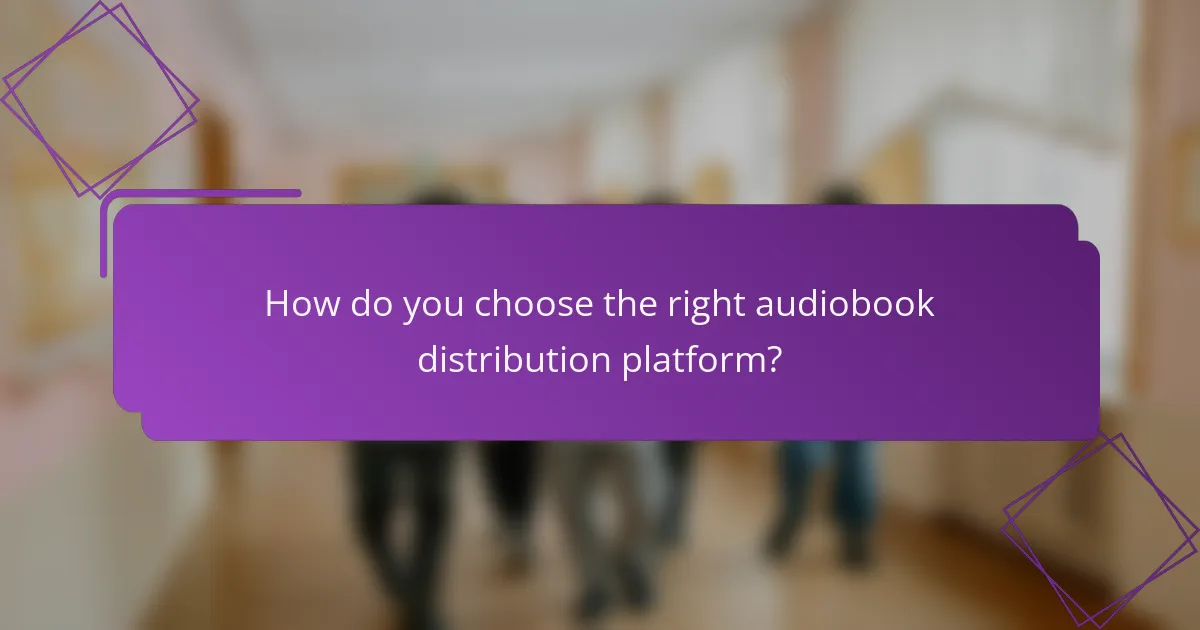
How do you choose the right audiobook distribution platform?
Choosing the right audiobook distribution platform involves evaluating your specific needs, such as target audience, pricing, and available features. Consider factors like royalty rates, distribution reach, and ease of use to find the best fit for your audiobook project.
Consider your target audience
Your target audience will significantly influence your choice of audiobook distribution platform. Identify where your listeners are most likely to purchase or stream audiobooks, whether it’s popular platforms like Audible or niche services. Tailoring your distribution strategy to meet your audience’s preferences can enhance your audiobook’s reach.
Evaluate pricing and royalty structures
Different platforms offer various pricing models and royalty rates. Some may charge upfront fees, while others take a percentage of sales. For instance, platforms like ACX typically offer between 25% to 40% royalties depending on the distribution model chosen. Analyze these structures to ensure they align with your financial goals.
Assess available features
Features can vary widely between audiobook distribution platforms. Look for options like promotional tools, analytics, and support services. For example, some platforms provide marketing assistance or detailed sales reports, which can be invaluable for tracking performance and optimizing your strategy. Prioritize features that will help you effectively manage and promote your audiobook.
Check distribution reach
The distribution reach of a platform is crucial for maximizing your audiobook’s visibility. Some platforms offer extensive networks, including major retailers and libraries, while others may focus on specific regions or genres. Ensure that the platform you choose can effectively distribute your audiobook to the audiences you want to reach.
Read reviews and testimonials
Before committing to a platform, researching reviews and testimonials can provide insights into the experiences of other authors. Look for feedback on customer service, ease of use, and overall satisfaction. This information can help you avoid platforms with consistent issues and guide you toward those that have a positive reputation in the industry.
